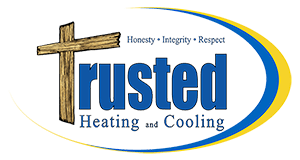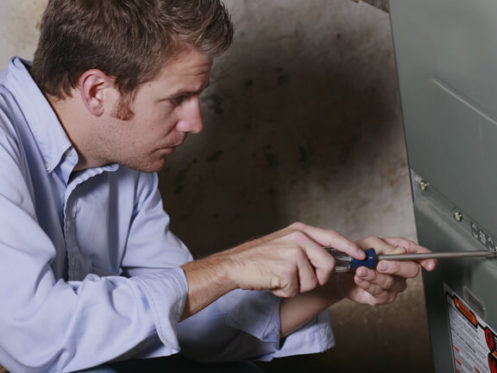7 Reasons Your Furnace Is Blowing Cold Air
Nothing is more frustrating than turning on the furnace in your Austin, Texas home only to find cold air coming from your air registers or air vents. Unfortunately, this is a fairly common problem and one with a variety of possible causes. The good news is that some issues are easy to troubleshoot. Following are several problems that cause furnaces to blow out cold air, along with a few simple tips for resolving them.
1. The Thermostat Setting Is Incorrect
Toggling the thermostat setting between “AUTO” and “ON” doesn’t always produce the results that people expect. When your thermostat is set to “AUTO,” your furnace will engage whenever your indoor temperature drops below your preferred level. Conversely, turning the thermostat to “ON” engages the system’s fan. Rather than producing and distributing heated air, your HVAC system will simply circulate the cold air that’s already in the building.
This is the first thing to check if you have multiple people in your home who regularly adjust the thermostat. When people feel cold and notice that the setting isn’t in the “ON” position, they often assume that moving it to “AUTO” will create the warmth they want. It’s an easy and all-too-common error.
2. You’ve Got Other Problems With Your Thermostat
An incorrect setting isn’t the only thermostat issue that can cause your furnace to blow out cold air. If you recently put your own thermostat in, your new unit might not be compatible with the type of heating and cooling equipment you own. If this is the case, it will need to be changed out before your furnace will function normally again.
If you haven’t replaced your thermostat in a while, this device may be incapable of triggering your furnace into action. In either case, you should have your thermostat inspected and repaired by a licensed HVAC technician.
3. It’s Time to Change Your HVAC Air Filter
Dirty air filters are among the most common causes of HVAC problems. Failing to replace these low-cost but all-important components on a regular basis can cause heaters and air conditioners to malfunction. Moreover, if you continue running your HVAC system after it’s started showing noticeable signs of distress, a dirty air filter could result in total system failure.
Dirty air filters impede normal airflow. This causes home heating systems to overheat. Having cold air coming out of your HVAC air vents may be an indication that your heating equipment is trying desperately to cool itself off. Shut your furnace down and take a minute to check your filter. If it’s dirty, replace it and then wait several minutes to one hour before attempting to start your furnace again.
4. You’ve Got Leaky HVAC Air Ducts
When HVAC ductwork ages, it often develops rips and tears that allow heated air to escape before it can be distributed throughout the home. Cold air enters ducts through these same cracks or other openings, and it winds up entering rooms instead. Leaky ductwork places a considerable amount of stress on HVAC equipment by greatly increasing the amount of work that it has to do. It also drives up home energy bills and shortens the lifespans of heaters and air conditioners.
If you’ve got leaky ductwork, your heated air is probably being deposited behind your drywall. You may be able to determine the location of duct damage by simply feeling around to find walls in your home that are hot even though their rooms remain chilly. Leaky, damaged ductwork should always be inspected and repaired by a licensed HVAC professional.
5. Your Furnace Is Old
New and highly efficient furnaces start producing and emitting steady streams of heat right away. However, as with all mechanical systems, furnaces tend to slow down and become less effective with age. Just as older vehicles need to be warmed up before taking them out on the open road, older furnaces often require several minutes to get going.
You may have cold air coming out of your HVAC ducts right after your heating system is turned on. If the problem persists, you should schedule a heating system inspection to identify its source. However, if the air coming out of your air registers or air vents gradually warms up, you’re probably on deck for a heater replacement.
Although most furnaces are rated to last 15 to 20 years, these ratings reflect ideal conditions. Most furnaces will only last two decades if they are properly sized for their service areas, diligently maintained, and repaired in a timely fashion. If you have an oversize or under-sized furnace, a furnace with a dubious maintenance history, or a furnace with multiple repair issues that have long been ignored, you can probably expect 10 years or less of reliable service.
6. Dirty Air Ducts
You don’t necessarily need a dirty air filter to have problems that are impeding your HVAC system’s airflow. It is possible for HVAC ductwork to be coated in dust and grime, even though air filters appear to be clean. This may be the case if small animals or insects have found their way into your HVAC system and have set up nests or other living areas within your ducting. Moreover, just as HVAC air filters need to be changed or cleaned, HVAC air ducts should be professionally maintained on a regular basis as well. Ductwork cleanings should be scheduled about once every three to five years based on your location, the needs of your household, and other factors.
You can check your air vents or air grilles to determine whether or not dirty ductwork is the source of your issue. Visible build-ups of lint, dust, and other debris on these components are likely a sign that the interior of your ductwork is just as filthy. Whenever airflow is impeded, home heating systems overheat. Once they do, they’ll stop producing and blowing heated air until the problem is resolved.
7. Problems With Integrated HVAC System Accessories
Having integrated HVAC system accessories put in is a great way to improve your home’s indoor air quality, regulate indoor humidity levels, and protect resident health. However, additions like air scrubbers, air purifiers, and media filters make HVAC systems and their functioning evermore complex. If these accessories aren’t installed correctly, aren’t diligently maintained, or aren’t compatible with the equipment they support, they can cause a host of issues.
If you have cold air coming out of your vents and have one or more integrated accessories, these add-ons could be the source of your trouble. When scheduling HVAC service, be sure to mention that you have added equipment installed directly in your HVAC ductwork. This will make it easier for your provider to identify and troubleshoot the problem.
Trusted Heating and Cooling has been providing reliable heating and cooling services to residents of Austin, Texas and the surrounding areas for many years. We also offer mini-split air conditioners and ductwork repairs. If your furnace is blowing out cold air, we can help. Give us a call today to schedule an appointment!

